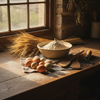Bread Pudding French Toast: The Ultimate Brunch Hack
Picture this: you're hosting brunch, and you want something that'll make your guests go "wow" without having you stress-scrambling in the kitchen all morning. Enter bread pudding french toast-the genius mashup that takes everything we love about custardy bread pudding and gives it that golden, caramelized French toast finish we crave.
Key Takeaways
- Bread pudding French toast is a perfect dish for impressing brunch guests effortlessly.
- This recipe combines the creamy texture of bread pudding with the crispy, caramelized finish of French toast.
- It offers a stress-free way to serve a delicious and memorable brunch.
Table of Contents
- What Is French Toast Bread Pudding?
- Choosing the Best Bread: Your Foundation for Success
- Key Ingredients for Success
- Step-By-Step Guide: How to Make French Toast Bread Pudding
- Serving Ideas & Customization
- Make-Ahead, Storage, and Freezing Tips
- Troubleshooting & Common Issues
- Essential Equipment for Success
- Your New Brunch Game-Changer
This isn't your average weekend breakfast. We're talking about a dish that's equal parts comfort food and showstopper, where day-old bread transforms into something magical. The best part? You can prep it ahead, pop it in the oven, and spend your morning actually enjoying your company instead of frantically flipping individual slices.
Whether you're feeding a crowd, meal-prepping for the week, or just want to elevate your brunch game, this bread pudding french toast recipe is about to become your secret weapon. And yes, we're going to show you exactly how to nail that perfect balance of crispy edges and creamy center-with tools that won't let you down when the heat is on.
Quick Answer
Bread pudding French toast combines the creamy, custardy interior of traditional bread pudding with the caramelized, golden exterior of French toast. Made by soaking cubed bread in a rich egg custard mixture and baking until set with crispy edges, it serves 6-8 people and can be prepared the night before for easy entertaining.
What Is French Toast Bread Pudding?
Let's clear up any confusion right off the bat. French toast bread pudding (also called bread pudding French toast) is essentially bread pudding's more glamorous cousin. While traditional French toast involves dipping individual slices in custard and cooking them one by one on the stovetop, this genius hybrid lets you achieve similar flavors and textures for a whole crowd-all in one dish.
Key Difference: Regular bread pudding is typically softer throughout and served as dessert, while French toast bread pudding maintains more structure and develops those coveted caramelized edges that make French toast so irresistible.
The magic happens when cubes of slightly stale bread soak up a rich custard base made from eggs, cream, milk, and warming spices like cinnamon and vanilla. But here's where it gets interesting-instead of the uniform, pudding-like texture you'd expect, the top layer develops a beautiful golden crust while the interior stays creamy and custardy.
Think of it as the ultimate brunch hack. You get all the indulgent flavors of French toast-that perfect marriage of sweet custard and bread-but with the convenience of a casserole. No standing over the stove, no timing multiple batches, no keeping plates warm in the oven. Just pure, crowd-pleasing brilliance.
When to Serve This Showstopper
This versatile dish shines in multiple contexts. For breakfast and brunch, it's an absolute game-changer-especially when you're hosting. Holiday mornings, weekend gatherings, or even special occasion breakfasts become infinitely more manageable when you can prep the night before.
But don't box it in as just a morning dish. Served warm with a scoop of vanilla ice cream, it makes an elegant dessert that'll have dinner guests asking for the recipe. Some of our favorite bread pudding french toast snooze-worthy moments happen when you're curled up on a Sunday afternoon, savoring leftovers with a cup of coffee.
Choosing the Best Bread: Your Foundation for Success

Here's where most people go wrong: they think any old bread will do. Not so fast. The bread you choose is literally the foundation of this dish, and picking the right type can make the difference between soggy disappointment and crispy-edged perfection.
Golden Rule: Slightly stale, thick-sliced bread is your best friend. Fresh bread gets mushy, while day-old bread maintains structure and soaks up custard like a champ.
The Hall of Fame: Best Bread Options
Brioche sits at the top of our list for good reason. This buttery, egg-rich bread brings natural richness and holds up beautifully to custard soaking. Its slightly sweet flavor complements the dish perfectly, and those irregular holes create pockets of creamy custard goodness.
Challah runs a close second with its similar egg-enriched structure and subtle sweetness. The braided loaves often come pre-sliced thick, which is exactly what you want. Plus, it's often available day-old at bakeries-score!
Texas Toast might seem like the underdog, but don't sleep on this option. Those thick, sturdy slices are specifically designed to hold up to moisture, making them ideal for custard absorption without falling apart. It's also the most budget-friendly option that still delivers excellent results.
For something more artisanal, French bread or Italian bread brings a slightly denser crumb that creates wonderful texture contrast. The crust adds extra chewiness, while the interior stays tender.
Pro Tip: If you only have fresh bread, cube it and spread on a baking sheet for 30-60 minutes to dry out slightly. You want it to feel firm but not rock-hard.
Textures to Embrace (and Avoid)
The ideal bread has a sturdy crumb that won't dissolve into mush but isn't so dense that it won't absorb the custard. Avoid super-soft sandwich breads or anything with large, airy holes that might create uneven soaking.
For our gluten-free friends, look for thick-sliced gluten-free brioche or challah-style breads. Many specialty brands now make excellent options that hold up well to custard soaking-just make sure they're a day old for best results.
Flavored breads like cinnamon raisin or cranberry walnut can add an extra dimension to your dish. Just remember that they'll contribute their own sweetness and flavors, so you might want to dial back the sugar in your custard base accordingly.
Size Matters: Aim for 1-inch thick slices, then cube them into roughly 1-inch pieces. This size ensures even soaking and creates the perfect bite-sized portions that cook evenly throughout.
Ready to move beyond bread selection? In our next section, we'll dive into the key ingredients that transform your chosen bread into custard-soaked perfection, plus share the exact ratios that create that ideal balance of creamy interior and golden-crisp top. Because with the right foundation and the right tools-like DI ORO's heat-resistant silicone spatulas that won't melt when you're transferring this beauty from oven to serving dish-you're already halfway to brunch hero status.
Key Ingredients for Success
Now that you've got your bread sorted, let's talk about the custard base that transforms those cubes into something magical. This isn't just about dumping eggs and milk together-the ratios, quality, and technique here make all the difference between restaurant-worthy bread pudding french toast and a soggy mess.
The Golden Ratio: For every 6 cups of cubed bread, you'll want 6 large eggs, 2 cups of dairy (milk + cream combo works best), and about 1/2 cup of sweetener. This creates the perfect custard-to-bread balance.
The Essential Custard Foundation
Eggs are your binding agents and richness providers. Large eggs work best-they give you consistent measurements and the right protein structure to set your custard without becoming rubbery. Don't even think about egg substitutes here; you need the real deal for proper texture.
Dairy combination is where things get interesting. Pure heavy cream creates incredible richness but can be too heavy for some palates. Pure milk lacks the luxurious mouthfeel we're after. The sweet spot? A 50/50 blend of whole milk and heavy cream, or go 2:1 milk to cream if you prefer something lighter but still indulgent.
Vanilla extract isn't optional-it's the aromatic backbone that makes this taste like French toast instead of just sweet bread. Use pure vanilla extract, not imitation. You'll need about 2 teaspoons for a standard batch, and don't be shy about it.
Cinnamon brings that warm, familiar French toast flavor we all crave. Ground cinnamon works perfectly, but if you want to get fancy, try mixing in a pinch of nutmeg or cardamom for complexity.
Temperature Matters: Let your eggs and dairy come to room temperature before mixing. Cold ingredients don't blend as smoothly, and you'll get better custard integration with your bread.
Sweetener Options That Actually Matter
Granulated white sugar is the classic choice-it dissolves easily and provides clean sweetness without competing flavors. But here's where you can get creative with your bread pudding french toast recipe.
Brown sugar adds molasses notes that complement the cinnamon beautifully. Use light brown for subtle depth, or dark brown if you want more pronounced caramel flavors. The moisture in brown sugar also contributes to a slightly more tender texture.
Maple syrup brings authentic breakfast vibes and liquid sweetness that blends seamlessly into your custard. Start with 1/3 cup instead of 1/2 cup granulated sugar, since liquid sweeteners taste more intense.
Turbinado or coconut sugar offer subtle complexity-turbinado has mild molasses notes, while coconut sugar brings almost butterscotch-like depth.
Optional Add-Ins for Next-Level Flavor
This is where your bread pudding french toast goes from good to unforgettable. These additions fold right into your custard or get layered between bread cubes:
- Toasted nuts: Walnuts, pecans, or almonds add crunch and richness
- Dried fruit: Raisins, cranberries, or chopped dried apricots for bursts of sweetness
- Fresh fruit: Blueberries, diced apples, or sliced bananas (add just before baking)
- Chocolate: Mini chips or chunks-because chocolate makes everything better
- Citrus zest: Orange or lemon zest brightens the entire dish
Dairy-Free and Sugar Alternatives
Need to accommodate dietary restrictions? You've got options that won't sacrifice flavor. For dairy-free versions, full-fat coconut milk creates incredible richness, while oat milk provides neutral flavor and good texture. Avoid thin plant milks like rice or almond milk-they won't give you the custard body you need.
Sugar alternatives work well here too. Monk fruit sweetener, erythritol, or stevia can replace traditional sugars, though you'll want to adjust quantities since they're typically sweeter than sugar. Start with half the amount and taste-test your custard before adding more.
Step-By-Step Guide: How to Make French Toast Bread Pudding

Ready to put it all together? This process is more forgiving than traditional French toast, but a few key techniques will guarantee success every time.
Bread Prep: Setting Your Foundation
Cut your chosen bread into 1-inch cubes-consistency matters here for even cooking. If your bread still feels too fresh, spread the cubes on a baking sheet and let them sit uncovered for 30-60 minutes. You want them to feel slightly firm but not rock-hard.
Remove crusts if you prefer a more uniform texture, but honestly? Those crusts add great textural contrast and help create those coveted crispy edges. Your call.
Pro Move: Lightly toast your bread cubes in a 300°F oven for 8-10 minutes if you want extra insurance against sogginess. This step isn't mandatory, but it's game-changing for super-fresh bread.
Making the Perfect Custard
In a large mixing bowl, whisk your eggs until well beaten-no streaks of white should remain. This is where a quality whisk makes all the difference, and having the right tools means no custard gets left behind when you're transferring between bowls.
Gradually whisk in your dairy mixture, then add sugar, vanilla, cinnamon, and a pinch of salt. That salt is crucial-it enhances all the other flavors without making the dish taste salty.
Here's a technique most recipes skip: gently warm your custard mixture in a saucepan over low heat, stirring constantly, just until the sugar completely dissolves. This takes maybe 3-4 minutes and ensures no gritty texture in your final dish. Let it cool slightly before proceeding.
Assembly: Where the Magic Happens
Butter your 9x13-inch baking dish generously-this prevents sticking and adds flavor. Layer half your bread cubes in the dish, sprinkle with half of any add-ins (nuts, fruit, chocolate), then add remaining bread and add-ins.
Pour the custard evenly over everything, then here's the crucial part: use a spatula to gently press the bread down, ensuring every piece gets custard contact. Let it sit for 15-20 minutes, pressing occasionally, until the bread has absorbed most of the liquid.
Overnight Option: This is actually when the dish gets even better. Cover and refrigerate overnight-the extended soaking time creates incredibly rich, custardy results. Just remember to let it come to room temperature for 30 minutes before baking.
Baking Techniques for Perfect Results
Preheat your oven to 350°F-this moderate temperature ensures the custard sets without curdling. Cover your dish tightly with foil and bake for 30 minutes. This covered phase lets the custard set properly without the top browning too quickly.
Remove the foil and continue baking for 25-35 minutes until the top is golden brown and a knife inserted in the center comes out mostly clean with just a few moist crumbs.
Doneness Test: The center should be set but still slightly jiggly-it will continue cooking from residual heat. An instant-read thermometer should read 160°F in the center.
For extra-crispy tops, switch to broil for the final 2-3 minutes, watching carefully to prevent burning. This creates those restaurant-quality caramelized edges that make bread pudding french toast snooze-worthy.
Let it cool for 10-15 minutes before serving-this allows the custard to firm up slightly for cleaner slicing. Trust us, the wait is worth it when you're using proper tools that won't scratch your baking dish or melt under the heat of fresh-from-the-oven goodness.
Serving Ideas & Customization
Your bread pudding french toast is golden, gorgeous, and ready to steal the show-but the right serving approach transforms it from impressive to absolutely unforgettable. Whether you're hosting weekend brunch or turning this into an elegant dessert, these serving strategies will have everyone asking for your secret.
Classic Breakfast & Brunch Presentation
For traditional brunch service, cut your bread pudding french toast into generous squares and plate them with a light dusting of powdered sugar. The contrast between the caramelized top and that snowy finish creates Instagram-worthy presentation every time.
Fresh berries aren't just pretty-they provide acidic brightness that cuts through the rich custard. Strawberries, blueberries, and raspberries all work beautifully, but here's a pro tip: toss them with a tiny bit of sugar and let them sit for 10 minutes. This creates natural berry syrup that pools around your bread pudding.
- Whipped cream: Fresh whipped cream with a hint of vanilla elevates everything
- Maple syrup: Warm it slightly for better pour and enhanced flavor
- Breakfast meats: Crispy bacon or sausage links provide savory balance
- Coffee pairing: Rich coffee or espresso drinks complement the custard perfectly
Dessert Variations That Impress
Transform your bread pudding french toast into an elegant dessert by serving it warm with premium vanilla ice cream. The temperature contrast-warm custard against cold cream-creates an incredible sensory experience that rivals any restaurant dessert.
Caramel sauce takes this dessert to the next level. Make it yourself by heating 1 cup sugar until amber, then whisking in 1/2 cup heavy cream and 4 tablespoons butter. The homemade version has depth that store-bought can't match.
For chocolate lovers, a warm chocolate ganache drizzle turns this into pure indulgence. Heat 1/2 cup heavy cream, pour over 4 oz chopped dark chocolate, let sit for 2 minutes, then whisk until smooth. This creates a glossy, restaurant-quality sauce that makes bread pudding french toast snooze levels of delicious.
Presentation Upgrade: Serve individual portions in ramekins or small cast-iron skillets for an upscale, personal touch. Guests love having their own portion, and it photographs beautifully.
Savory Variations for the Adventurous
Who says bread pudding french toast has to be sweet? Savory versions work brilliantly for brunch or light dinner. Replace the sugar with herbs like thyme or rosemary, fold in grated Gruyère or sharp cheddar, and serve alongside crispy bacon or breakfast sausage.
Try a Mediterranean approach: use day-old focaccia, add sun-dried tomatoes and fresh basil to your custard, top with crumbled goat cheese. Serve with a simple arugula salad dressed in lemon vinaigrette for a sophisticated brunch that feels effortlessly elegant.
Make-Ahead, Storage, and Freezing Tips

The beauty of bread pudding french toast lies partly in its make-ahead friendly nature. This dish actually improves with time, making it perfect for stress-free entertaining or meal prep.
Prepping Ahead for Entertaining
Assemble your entire dish up to 24 hours before baking. The extended soaking time allows the bread to absorb every bit of custard, creating incredibly rich, uniform texture throughout. Cover tightly with plastic wrap and refrigerate-just remember to let it come to room temperature for 30-45 minutes before baking.
For maximum flexibility, prepare your custard and cube your bread separately. Store the custard in the refrigerator for up to 2 days, and keep bread cubes in an airtight container at room temperature. This approach lets you adjust quantities or swap bread types right up until assembly.
Time-Saving Strategy: Prepare two smaller 8x8 dishes instead of one large pan. Bake one fresh, freeze the second for later. This gives you built-in meal planning and perfect portion control.
Storing Leftovers Properly
Leftover bread pudding french toast keeps beautifully in the refrigerator for up to 4 days when stored in an airtight container. For best results, let it cool completely before refrigerating-this prevents condensation that can make the texture soggy.
Reheating requires a gentle touch to maintain that perfect custard texture. Cover individual portions with a damp paper towel and microwave for 45-60 seconds, or reheat larger portions in a 350°F oven, covered with foil, for 15-20 minutes until warmed through.
For freezing, wrap cooled portions tightly in plastic wrap, then aluminum foil, or use freezer-safe containers. Properly stored, it maintains quality for up to 3 months. Thaw overnight in the refrigerator, then reheat using the oven method for best texture recovery.
Troubleshooting & Common Issues
Even with the best bread pudding french toast recipe, things can occasionally go sideways. Here are the most common problems and their solutions:
Perfect Results Indicators
- Golden-brown, slightly crispy top surface
- Custard that's set but still tender throughout
- Clean knife test with just a few moist crumbs
- Individual bread pieces visible but unified by custard
Common Problems to Avoid
- Soggy, mushy texture from over-soaking or wrong bread
- Dry, tough results from insufficient custard or overbaking
- Curdled custard from too-high temperature or rushed mixing
- Uneven cooking from improper assembly or dish size
If your bread pudding turns out too wet, it's usually because the bread wasn't stale enough or you used too much custard. Next time, let your bread cubes sit out longer, or lightly toast them before assembly. If it's too dry, increase your custard ratio slightly and make sure you're covering the dish during the first phase of baking.
Curdled custard happens when temperatures get too high too fast. Keep your oven at 350°F or lower, and always use the covered-then-uncovered baking method. If you're warming your custard on the stovetop, keep the heat low and stir constantly.
Essential Equipment for Success
The right tools make the difference between frustrating kitchen struggles and smooth, confident cooking. For bread pudding french toast, you need equipment that can handle high heat, won't react with acidic ingredients, and makes cleanup effortless.
A quality 9x13-inch baking dish is non-negotiable-ceramic or glass work beautifully and distribute heat evenly. Avoid metal pans that can react with dairy and create off-flavors. For mixing, you'll want bowls that won't retain odors and whisks that can handle thick custard without bending.
Heat-Resistant Tools Matter: When you're working with hot custard and transferring between stovetop and oven, your spatulas and serving tools need to withstand high temperatures without melting, warping, or releasing harmful chemicals into your food.
Professional-grade silicone tools excel here-they're heat-resistant to 600°F, won't scratch your baking dishes, and clean up easily. Look for seamless construction that won't harbor bacteria, and pro-grade materials that are free from forever chemicals. After all, when you're creating something this special for family and friends, every detail matters.
Your New Brunch Game-Changer
Bread pudding french toast delivers everything you want in a showstopper breakfast: impressive presentation, incredible flavor, and surprisingly simple execution. It's the dish that turns regular weekend mornings into something memorable and makes hosting brunch feel effortless instead of stressful.
The beauty lies in its flexibility-customize with your favorite add-ins, prepare it ahead for stress-free entertaining, or transform it into an elegant dessert. Whether you're following a classic bread pudding french toast recipe or creating your own signature version, you're guaranteed results that rival any restaurant.
Most importantly, this dish proves that the best cooking happens when technique meets creativity. With quality ingredients, proper equipment, and these proven methods, you're not just making breakfast-you're creating experiences that bring people together around the table.
So grab that day-old bread, whisk up some custard, and get ready to become the brunch hero your family and friends never knew they needed. Trust us, once you serve this bread pudding french toast snooze-worthy creation, regular French toast will never feel quite the same again.
For more creative breakfast inspiration, check out our kale egg bake for another crowd-pleasing brunch option.
If you're interested in the history behind this classic, explore the origins of bread pudding and how it became a beloved comfort food.




